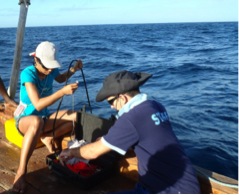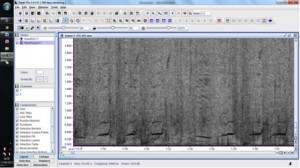Zanzibar Humpback Whale Research Project 2012
Distinct and beautiful songs of the male humpback whales have been making waves in Zanzibar and our research team has been able to take full advantage with some lengthy recordings using a specialised hydrophone to allow for the low frequency sounds to be picked up.
The preliminary results have been very encouraging with the majority of the songs being visible in the analysis.
When the team analyse the songs we use a specialised bioacoustics program. This allows for the song to be viewed on a graph, a spectrogram. Humpback whale songs are relatively complex but they have distinctive patterns that may be used for analysis. Each song is about 20-30 minutes long but may be repeated for several hours. The song is divided into different sections, the largest being themes. These themes can then be further broken down to smaller fragments called phrases and units.
The organisation and structure of the songs is of particular interest to Nat Stephenson (research assistant and Newcastle undergraduate student) who will be analysing the recordings for his dissertation project. Nat will be comparing the songs from this year to recordings from previous years to look for changes within season and also changes over a greater temporal span.
The songs are seen as a crucial ingredient in the mating behaviour of humpback whales and we hope that the song analysis in combination with all other data we are collecting will give us further understanding about the humpback whales off east Africa.
 Nat and Kristin deploying the hydrophone to record humpback whale song.
Nat and Kristin deploying the hydrophone to record humpback whale song.

Example of humpback whale song (dark wiggles) as shown in a spectrogram.
Photographs © Zanzibar Humpback whale Project
